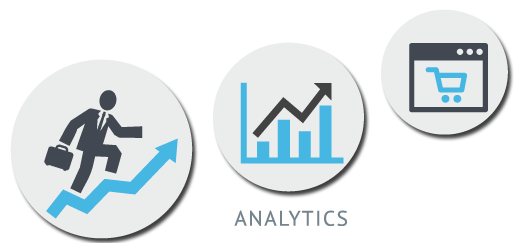
What Is Website Conversion And How You Can Measure It
Website conversion is all about efficiency in planning and implementation. Whether it is to sign up for your newsletter, download a digital asset, create an account or buy your product, your visitors will take the desired action as long as your landing page is optimized for it.
How?
Firstly, you should determine the conversion point: do you want to generate leads or sales?
Google Analytics can gather data regarding leads and traffic from your website so that you are able to calculate the conversion rate: leads collected/total traffic to the website)x 100= conversion rate.The answer differs from industry from industry, but there are a few good general numbers. For example, visitor-to-lead conversion rates can exceed 15% in business-to-consumer website, whereas in B2Bs, conversation rates only range between 5-8%.
Current Tools For Website Conversion
There are 3 simple things to remember when improving conversion rates:
- Making your call-to-actions obvious.
- Following the mud-tracks and adjusting accordingly.
- Asking your visitors what they want.
Google Analytics – free
Allowing you to track website behavior, traffic sources, engagement and e-commerce sales, good old Google Analytics is one of the most popular tools available on the market.
Clicktale – free up to 5,000 recordings/month
Clicktale will record website visitors without intruding their privacy. This is essential in learning how your visitors use the site and what their overall experience is like.
Mixpanel – free up to 25,000 data points
Mixpanel is an advanced analytics tool for both mobile and web. t is different from Google Analytics because this one helps you also analyze visitor’s action, not only page views. This tool is the key to understanding how people interact with your website
Survey Monkey – free up to 10 questions and 100 responses
Survey Monkey is a research tool which helps you understand what turns visitors into customers.Your success rate depends on the type of questions you choose to ask.They should reveal how the visitor feels about your product or website, so questions like “What made you buy the product?’ or “What’s your favourite thing you like about the product?’ are a good way to get insight.
Fivesecondtest – free for 20 responses/pro version $99/month
Speaking of getting valuable insight, Fivesecondtest facilitates the communication between you and your visitors. It is, as the name says, a five second test, during which users are shown a 5 second version of your new design and then will be asked a set of questions who will help you identify the most obvious elements the users remember.
Hellobar – free
If you want your users to be active, you need to act likewise. Hellobar is an optimization tool that will display a visible bar at the top of the page in order to get the visitors’ attention. Its best use is to create a call-to-action and the most efficient one is signing up for your newsletter. However, you could use it to promote events or to mark milestones from time to time.
Emolytics by GetSmily
Emolytics provides a plugin you can display on your website that will help determine the mood of your visitors. It gives you in depth understanding of your customers. Emotions are the basis on what most people make decisions. By surveying every visitor, you are identifying the reason that led them to your website. You’re not just asking how they’re feeling. What you’re really asking is WHY are they feeling the way they do. The answers are gathered in reports, graphics and charts and will help you make informed decisions for your business.
Future Trends
A/B and Multivariate Testing
A/B Testing refers to comparing only two versions at the same time, so your visitors can decide which one performs better. It works by alternately displaying two versions of your site. It can only display minor changes, such as headlines or buttons or even a complete redesign of your page. Why A/B does is helps you make informed decisions instead of relying on hunches and guesses, so that next time you launch a feature, testing it allows you to determine whether it’s a go or not before committing to any drastic changes, which may turn out to be unnecessary.
Multivariate testing enables simultaneous testing pages for all variations of page elements being tested, which will lead to an effective combination of design elements to achieve your goals. AB testing is somewhat similar to multivariate testing, only the in the latter, multiple variables are tested together in order to determine the ideal combination that is the most effective in improving your ultimate goal. Therefore, multivariate testing as a method of website optimization is a powerful way of gathering visitors and gaining complex insight into your customers’ behaviour. They key is continuous testing, which will lead to significant conversion gains.
Pageless Web Design
How is it that mobile apps are more enjoyable and enticing than web versions? Well, in all honesty, it comes down to the incredibly expensive cost of exceptional web design. Pageless design is an affordable web design method, that centers around creating a compelling story for your customers on a single page website. Although it is not a tool per-se, its effectiveness is a factor not to be missed out.
It is notably a great feature for medium or small size businesses and here is why:
- Rather than having your website divided in multiple pages, the entire website is displayed on a single page that follows a storyline, which will lead to a decrease in the bounce rates, therefore, more time spent on the website.
- It is intuitive, so users don’t get confused and they are less likely to abandon the web experience.
- It is mobile friendly, so mobile optimization will be less difficult. Also, it is social media friendly, because it invites and enables visitors to share your content. With traditional sites, users have to choose a specific page to share, whereas in pageless design sites significantly simplifies the decision making process.
- Stories motivate, inspire and have a humanizing factor. People like doing business with other people. Through pageless design, you can create captivating, interactive or emotional experience in more powerful ways than traditional web design ever could.
- Most importantly, it is proven to create higher conversion rates, which should be the one metric that matters the most. Its clean, linear and elegant approach keeps users engaged longer periods of time.
- A customized website can get extremely expensive. However, pageless websites can be made at much more affordable prices than other options, many versions under $5,000.
Online Shopping Personalization
According to Invesp, 56% of shoppers are more likely to shop on a site that provides personalized recommendations and personalized ads convert 10 times better than standard ads. Simply put, personalizing your e-commerce site and the ads will lead to increasing loyalty, generating more new customers and, naturally, driving more revenue.
Successful Case Studies
Amazon
While on the subject of personalized recommendation, Amazon is known to have done it for years. Amazon.com is widely known for testing every change on its site and never settling for anything less than high converting designs. Also, Amazon has a great personalization strategy that starts right on the homepage, where each user sees different sections such as ‘’Inspired by Your Viewing Trends’’ or ‘’Related to Items You’ve Viewed’’
However, what may be working for Amazon, may not be working for you, since most web sites do not need as much personalization to increase conversion rates as Amazon does. It is perfectly acceptable to get inspired by Amazon’s strategy, but test it first. When implementing improvements to your website, do not forget to run some tests first.
Walmart Canada
Another great case study is how Walmart.ca managed to increase their conversion rates by 20% through redesign. It took Walmart Canada almost a year to make their site fully responsive, but all costs paid for themselves within months.
Walmart realised that most of the traffic comes from mobile devices and that their current web site only worked great on the web version. Their mobile version did not look so attractive and it also took forever to load. They gathered plenty of data about most used screen sizes and browsers and took action. They performed A/B testing and multivariate testing and in the end, with the final design, Walmart achieved a 20% conversion boost on all devices. Furthermore, on mobile, orders went up by nearly 98%, which is impressive to say the least.
Conclusion
There are plenty of tools on the market, some of them even free of charge. You have no more excuses for doubling your conversion rates. And even though there sometimes might be some costs involved, they will pay for themselves in the long run.
Tell us what are some of your favourite conversion rate optimization tools? We’d love to know how they’re working for you so feel free to share your experiences by leaving a comment below.



